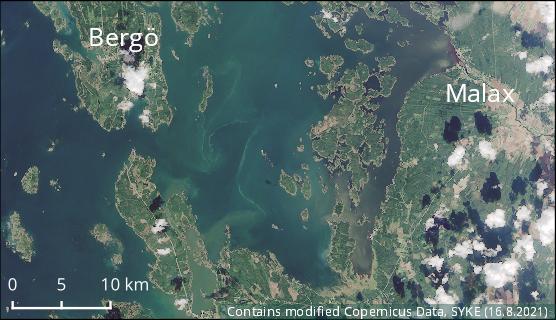Press release 2021-08-19 at 14:19

Blue-green algae off Maalahti, south of Vaasa. © Contains modified Copernicus Sentinel-2 data, SYKE (2021)
The amounts of blue-green algae in lakes and coastal areas are still smaller than average. Only in some areas of the Archipelago Sea have abundant cyanobacteria been observed in coastal areas. As is typical for the late summer, the amounts of cyanobacteria have continued to decline in open sea areas.
More in Finnish
SYKE observes the cyanobacteria occurrence as part of the monitoring of the state of the environment
The national cyanobacterial monitoring is based on the monitoring of cyanobacterial deposits in surface water, and the intention is to provide an overview of the cyanobacterial situation in different water bodies. Observations are carried out as part of the monitoring of the state of the environment in cooperation with the Centres for Economic Development, Transport and the Environment, municipal environmental and health authorities and the Finnish Environment Institute. Finnish Rotary Clubs are also actively involved in nationwide cyanobacterial monitoring.
This summer, cyanobacterial monitoring includes about 400 permanent observation sites across the country on inland and coastal waters and in the archipelago. Information on the cyanobacterial situation in the open seas is mainly obtained from satellite images, but also from the Finnish Border Guard, the marine research vessel Aranda, the optical device located at the Utö Atmospheric and Marine Research Station as well as cruise and merchant ships (MS Finnmaid and MS Silja Serenade) equipped with Alg@line measuring equipment. The drift forecasts for cyanobacterial rafts in open sea areas are prepared in cooperation with the Finnish Meteorological Institute's Maritime Services.
The Finnish Environment Institute usually reports on the national cyanobacterial situation on a weekly basis every Thursday from the beginning of June until the end of August. The weekly algal reporting on the national cyanobacterial monitoring was launched in 1998.
Several compounds produced by cyanobacteria can cause health hazards
According to the guidelines of the National Institute for Health and Welfare (THL), water rich in cyanobacteria should always be treated in such a way that it may be harmful to health. Cyanobacteria produce a number of different compounds that can cause symptoms. Some cyanobacteria can produce liver or nerve toxins, but most of the symptoms experienced by swimmers may also be due to other compounds.
Especially small children and pets should be kept out of water rich with cyanobacteria. Water with cyanobacteria should not be used in the sauna or as washing or irrigation water. If poisoning is suspected, seek medical advice or take your pet to a veterinarian. If necessary, the Poison Information Centre will provide additional instructions.
The municipal health authorities monitor the cyanobacterial situation on the beaches.
Report your cyanobacterial observations to the Järvi-meriwiki (Lake and sea wiki)
In the Järvi-meriwiki maintained by the Finnish Environment Institute, everyone has the opportunity to establish their own observation site and share cyanobacterial observations from lakes and coastal areas. Individual observations can also be sent, for example, from beachs or during boat trips. The observations can be submitted via the Havaintolähetti website and they displayed on the national cyanobacterial situation map supporting the national assessments of the cyanobacterial situation. Observations about the absence of cyanobacteria are also important.
Municipalities and cities monitor the cyanobacterial situation on the beaches, so it is advisable to report rich cyanobacterial occurences on beaches also to the health authorities of the municipality in question.
Cyanobacterial observations also in the Itämeri.fi and vesi.fi services
Last summer, for the first time, websites on the cyanobacterial observations on the Itämeri.fi service and the Vesi.fi service were also launched. The cyanobacterial map presented on this algal bloom observations page combines the observations reported to the Järvi-meriwiki and from the beaches of the City of Helsinki as well as the observations based on satellite interpretations of the Finnish Environment Institute during the last three days.
This is how you identify cyanobacteria
A small amount of cyanobacteria in the water appears as green or yellowish particles. Narrow stripes of algae can drift to a beach. In calm weather, a substantial amount of cyanobacteria forms greenish or yellowish algal rafts and piles up in coastal water. Unlike cyanobacteria, pollen is found not only on the surface water but also, for example, on piers or yard furniture.
If the algae dissolve into tiny particles in the water when you touch it with a stick, it may be cyanobacteria. If the algae attache to the stick, it is something other than cyanobacteria. In a glass of water, cyanobacteria rise to the surface as tiny greenish particles within about an hour.
Algae bloom risk analysis
Information about algae situation
TARKKA-service
You can monitor the cyanobacterial situation via satellite observations through the TARKKA service. Observations are collected daily in the service from both sea and lake areas.
More information
(Telephone 1.00 - 3.00 pm)
Lakes
-
University Intern Jere Laine, Finnish Environment Institute SYKE, Tel. +358 295 252 193, firstname.lastname@syke.fi
-
Senior Research Scientist Kristiina Vuorio, Finnish Environment Institute SYKE, Tel. +358 295 251 757, firstname.lastname@syke.fi
Sea areas
Coastal cyanobacterial observations
- Senior Research Scientist Sanna Suikkanen, Finnish Environment Institute SYKE, Tel. +358 295 251 660, firstname.lastname@syke.fi (until 20 August)
- Senior Research Scientist Sirpa Lehtinen, Finnish Environment Institute SYKE, Tel. +358 295 251 353, firstname.lastname@syke.fi (from 23 August)
Offshore cyanobacterial observations
- eotuki@syke.fi
- Reseacher Hanna Alasalmi, Finnish Environment Institute SYKE, Tel. +358 295 251 064
State of the Baltic Sea
-
Senior Research Scientist Heikki Pitkänen, Finnish Environment Institute SYKE, Tel. +358 295 251 286, firstname.lastname@syke.fi (until 20 August)
-
Leading Researcher Harri Kuosa, Finnish Environment Institute SYKE, Tel. +358 295 525 1106, firstname.lastname@syke.fi (from 23 August)
Communications
- Communications Intern Sofia Patama, Finnish Environment Institute SYKE, Tel. 0295 252 245, firstname.lastname@syke.fi